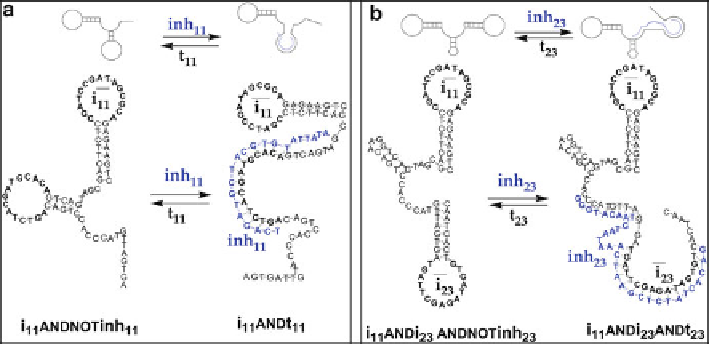Biomedical Engineering Reference
In-Depth Information
Fig. 17.2
(
a
) An AND gate (i
11
ANDt
11
) is derived by pre-complexing an ANDNOT gate
(i
11
ANDNOTinh
11
) with the matching inhibitor oligonucleotide (inh
11
) that inhibits the enzymatic
activity. The addition of t
11
, which is complementary to inh
11
, reconfigures the gate back to
its original state. (
b
) An ANDAND gate (i
11
ANDi
23
ANDt
23
) is derived by pre-complexing
an ANDANDNOT gate (i
11
ANDi
23
ANDNOTinh
23
) with the matching inhibitor oligonucleotide
(inh
23
). The addition of t
23
, which is complementary to inh
23
, reconfigures the gate back to its
original state
MAYA-III incorporates 4 AND and 12 ANDAND molecular logic gates (pre-
complexed with inhibitor to inhibit the enzymatic activity), 1 fluorescent-labeled
substrate, 8 training inputs, and 8 game-playing inputs. AND gates are obtained
through modification of previously reported ANDNOT gates [
36
] which accept two
allosteric oligonucleotide inputs, one promoting the activity of the deoxyribozyme
and the other inhibiting it. An inhibitor oligonucleotide is pre-complexed with
ANDNOT gate to switch this gate into its inhibited state functionally equivalent
to an AND gate. Thus, in the training procedure, the addition of a training input
complementary to the inhibitor reconfigures this AND gate into a YES gate.
ANDAND gates are obtained through the modification of the ANDANDNOT
gates [
43
]. In this case, inhibitor and game-playing input are made different by
extending the inhibitor so it can also interact with the catalytic core. The inhibitor
is pre-complexed with ANDANDNOT gate to switch it into an ANDAND gate
(see Fig.
17.2
). Thus, in the training procedure, the addition of a training input
complementary to the inhibitor reconfigures ANDAND gate into an AND gate.
The protoautomaton is a mixture of individual 16 molecular logic gates iden-
tically distributed into each of the four wells representing the game board (see
Fig.
17.3
a). The training for each strategy consists of the distribution of eight
training oligonucleotides into the assigned individual wells based on the strategy
desired (see Fig.
17.3
b). After training, the automaton accepts correct human moves
encoded as input oligonucleotides and responds by activating a fluorogenic reaction
in a response well based on the taught strategy (see Fig.
17.3
c, d). MAYA-III uses

Search WWH ::

Custom Search